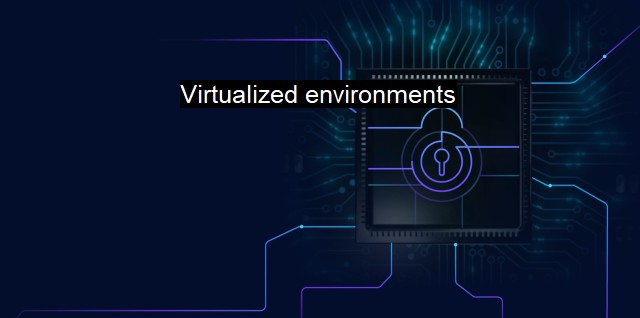What are Virtualized environments?
The Impact of Virtualized Environments on Modern Antivirus Solutions: Maximizing Resource Utilization & Improving Cybersecurity
Virtualized environments offer a new and innovative approach to managing and securing networks, systems, and data. Generally, virtualization refers to the creation of a virtual, rather than actual, version of something, such as operating systems, servers, storage devices, or network resources. In other words, this technology can partition a single physical server into multiple virtual servers that can run their own operating systems and applications.From a cybersecurity standpoint, virtualized environments create a multilayered defense mechanism. The first layer of this multilayered defense is segregation. With virtualization, critical assets can be segregated from the others by placing them in isolated environments that are virtual and not linked to the network physically. This technology can enhance system security by allowing complete isolation of one system from another. As a result, failing or infected systems can easily be replaced without the risk of corrupting the whole IT estate.
Even if an attacker is successful in penetrating a virtualized server, the exploit is limited to only that server. This containment prevents the spread of malware or a cyber attack to other servers, limiting their scope. This limitation makes it easier to detect, analyze, and eradicate any potential cyber threats. The virtualized environment, therefore, not only provides better containment but also greater visibility into anomalous behavior and activities that could signify a cybersecurity incident.
Virtualization also offers another vital advantage from a security perspective through the ability to readily backup or snapshot a system. Snapshot involves capturing the state, data, and configuration of a virtual machine at a specific point in time. Should these systems be compromised via a cyber attack, they can quickly be reverted to a previous snapshot that was not affected, minimizing business disruption and downtime.
Hosts can securely and quickly distribute services to other parts of the network and beyond through the virtualization of networking and security services. This capacity enables them to keep pace with dynamic security conditions, such as changing traffic patterns and the shifting strategies of cyber attackers. In the event of a cyber-attack, the divergent paths and reduced visibility affect the attacker’s ability to infiltrate the network and cause harm, while giving security well placed points for countermeasures.
From an antivirus point of view, virtualized environments have redefined how antivirus and antimalware tools are implemented. In a virtualized environment, it is possible to offload antivirus and antimalware activities to a dedicated security virtual machine that is separate from the other VM's. This offloading minimizes the drain on system resources and improves overall performance. Even more, through virtualization, one can create decoy VMs to lure cyber attackers away from systems with sensitive data, a strategy known as cyber deception.
Virtualization, when correctly implemented, delivers significant security and business benefits. it continuously evolves into more complex forms to counter increasingly advanced cyber-threats. While it provides robust security, it is crucial to reinforce these environments with facilitated security processes, patch management, and automated security settings.
Virtual environments significantly contribute to cybersecurity and antivirus landscapes. The ability to segregate and isolate systems, adapt to dynamism, readily backup, snapshot, offload antivirus activities to a separate environment, and cyber deception strategy help secure IT ecosystems against cyber threats. while virtualization provides an additional layer of security, it should be appropriately managed and fortified with other defense mechanisms like intrusion detection systems, encryption methods, and isolation strategies to maintain a comprehensive security stance.

Virtualized environments FAQs
What is a virtualized environment?
A virtualized environment is a technology that allows multiple operating systems, applications, and servers to run on a single physical machine. This enables IT professionals to create isolated and secure environments for different purposes, such as testing, development, and production.What are the advantages of virtualized environments in cybersecurity?
Virtualized environments can provide a high level of security for cybersecurity purposes. They allow IT professionals to isolate potentially vulnerable systems and applications, making it harder for hackers to exploit vulnerabilities. Additionally, virtualization can help prevent malware infections by providing a sandboxed environment for analyzing suspicious files and programs.What are the risks associated with virtualized environments and antivirus software?
One potential risk of virtualized environments is that antivirus software may not function properly due to the abstraction layer between the virtual machine and the physical hardware. This can make it more difficult to detect and remove malware. However, many antivirus vendors now offer specific solutions for virtualized environments to address these issues.What measures can be taken to secure virtualized environments from cyber attacks?
To secure virtualized environments from cyber attacks, IT professionals should ensure that virtual machines are properly configured and updated with the latest security patches. They should also implement network segmentation and isolation to prevent lateral movement by attackers. In addition, regular security audits and vulnerability assessments can help identify and address potential security weaknesses in virtualized environments.| | A | | | B | | | C | | | D | | | E | | | F | | | G | | | H | | | I | | | J | | | K | | | L | | | M | |
| | N | | | O | | | P | | | Q | | | R | | | S | | | T | | | U | | | V | | | W | | | X | | | Y | | | Z | |
| | 1 | | | 2 | | | 3 | | | 4 | | | 7 | | | 8 | | |||||||